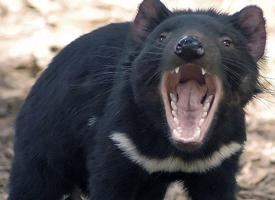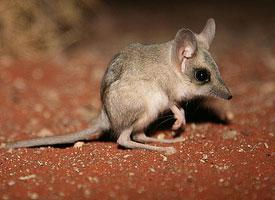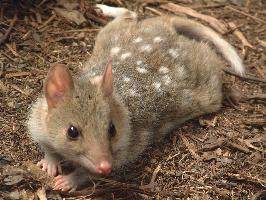
Známé také jako
- Tasmánský čertík
- Tasmánský čert
Váhy a míry
| Délka | od 57 do 65,2 cm |
|---|---|
| Hmotnost | od 6 do 8 kg |
| Délka ocasu | od 25,8 do 24,4 |
Biologická data
| Délka života | 6 r |
|---|---|
| Délka březosti | 21 d |
Popis zvířete
The Tasmanian devil (Sarcophilus harrisii) is a fascinating and unique carnivorous marsupial, native exclusively to the Australian island state of Tasmania. With its stocky, muscular build, coarse black or brown fur, and an impressively loud and ferocious demeanor, the Tasmanian devil is an iconic symbol of Tasmania's rich biodiversity. Despite its fierce reputation, this creature is a vital part of the ecosystem, playing a crucial role in controlling the population of other animals and in the scavenging process.Adult Tasmanian devils typically weigh between 6 to 8 kilograms, though their size can vary significantly. They possess a broad head with strong jaws capable of exerting one of the most powerful bites per unit body mass of any living mammalian carnivore. This powerful bite allows them to crush bones and tear through flesh, which is particularly useful given their scavenger nature, allowing them to consume the entirety of their prey, leaving little to waste.
The Tasmanian devil's diet is primarily carnivorous, feasting on small prey such as birds, fish, and insects, as well as carrion. They are solitary creatures, coming together only to feed or mate. Despite their solitary nature, feeding times can be quite social, albeit noisy, events. The sounds they produce during these gatherings, including growls, screeches, and snarls, contributed to their ominous name. These sounds, combined with their ferocious eating habits, make the Tasmanian devil an intimidating presence in the animal kingdom.
Breeding season for the Tasmanian devil occurs once a year, and the competition among males for a mate can be fierce. Females give birth to very small, undeveloped young, which then must crawl into the mother's pouch to continue developing. The pouch, however, only has four nipples and can carry a maximum of four offspring, despite the fact that the female may give birth to 20 to 30 young. This high level of infant mortality is one of the many challenges this species faces.
In recent years, the Tasmanian devil population has faced significant threats, most notably from a contagious cancer known as Devil Facial Tumour Disease (DFTD). This disease has led to a dramatic decline in the Tasmanian devil population, classifying it as endangered. Efforts are underway to save this unique species, including breeding programs in captivity and on disease-free islands, along with extensive research into the disease itself.
Despite their daunting appearance and the myths surrounding them, Tasmanian devils are an integral part of Tasmania's natural heritage. Their decline not only affects biodiversity but also alters the ecosystem dynamics. Conservation efforts continue to be crucial in ensuring the survival of the Tasmanian devil, a remarkable creature that has roamed the landscapes of Tasmania for thousands of years.
Podobná zvířata
Nové fotografie zvířat
Top 10 zvířat
- Chinese water dragon (Physignathus cocincinus)
- Galápagos tortoise (Geochelone nigra complex)
- Dolphin gull (Leucophaeus scoresbii)
- Japanese macaque (Macaca fuscata)
- Colombian red howler (Alouatta seniculus)
- Sea urchins (Echinoidea)
- Moustached guenon (Cercopithecus cephus)
- Diana monkey (Cercopithecus diana)
- Common reed warbler (Acrocephalus scirpaceus)
- Common house mosquito (Culex pipiens)

